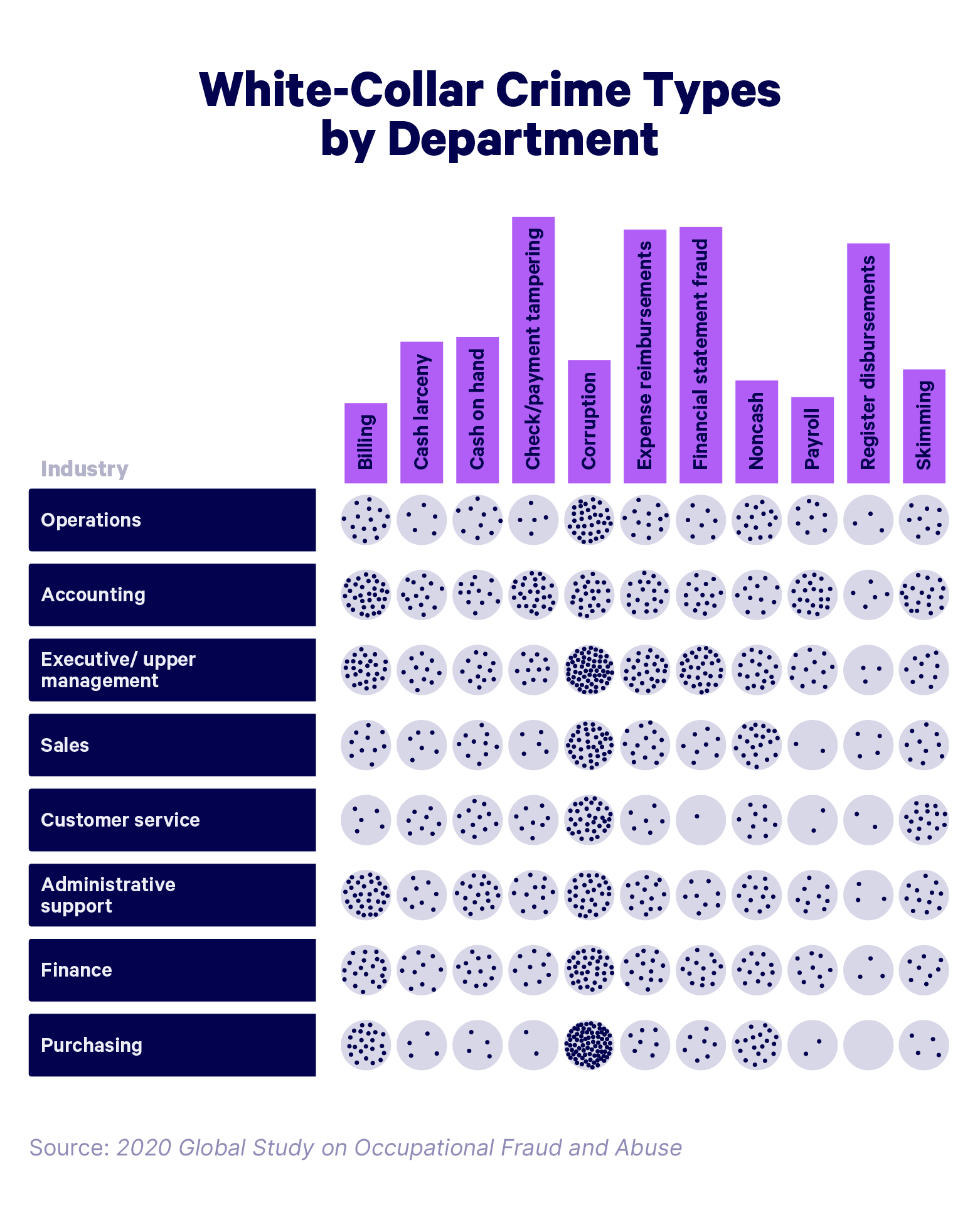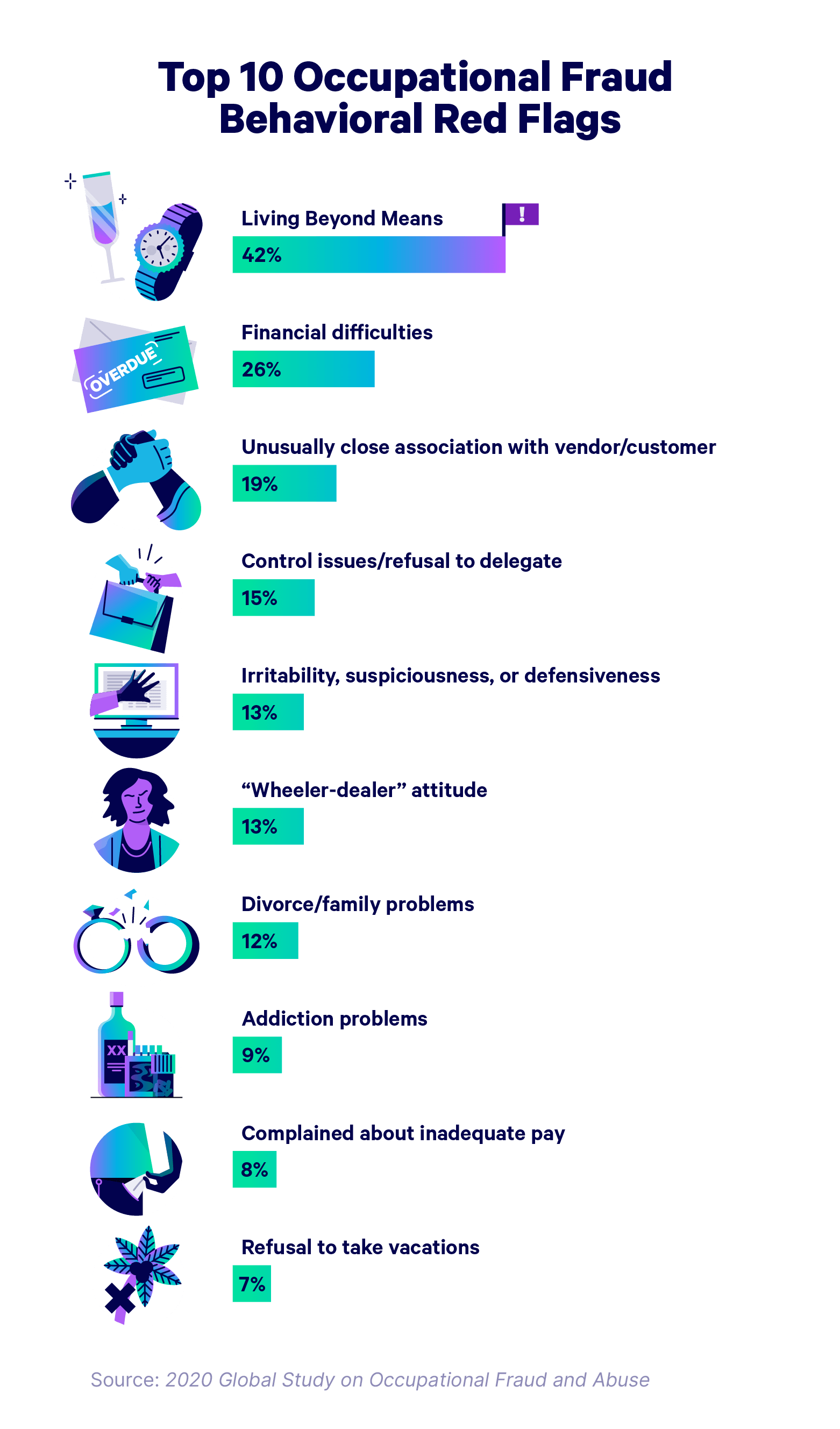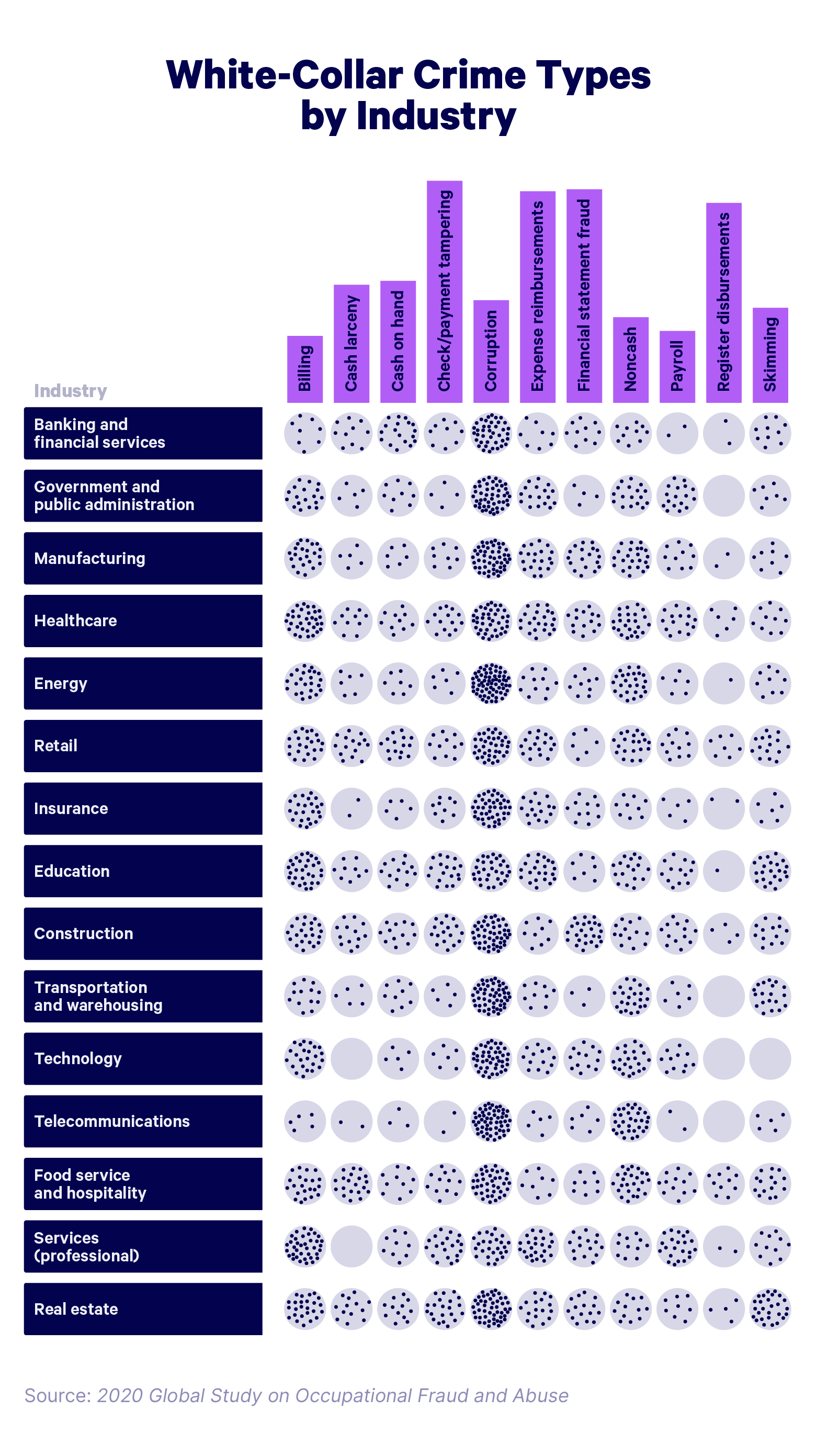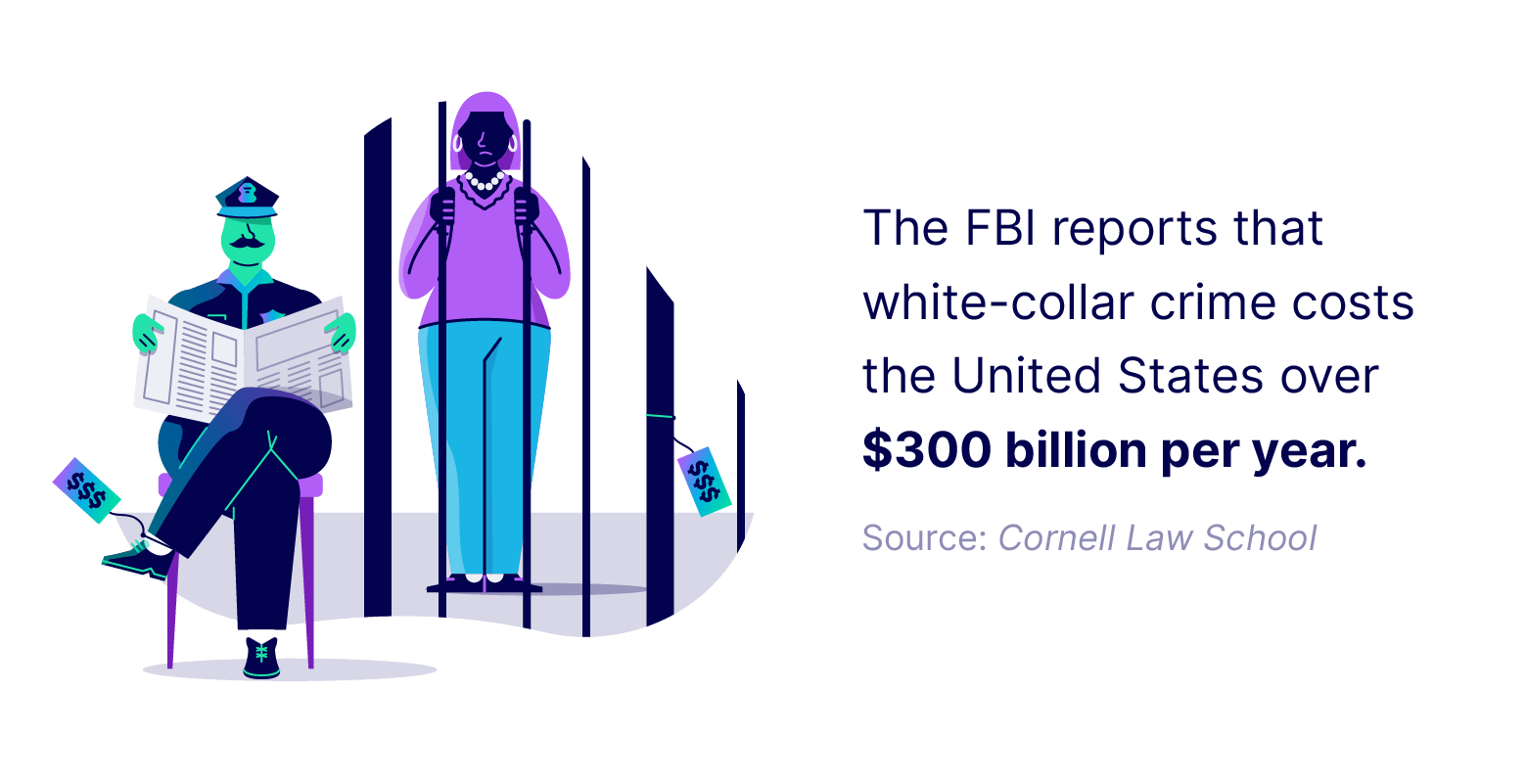45 fascinating white-collar crime statistics for 2025
Protect your business today!
Get a QuoteYou may think of white-collar criminals as extravagant Wolf of Wall Street types with extreme personalities and habits that make them easy to spot. But in reality, these criminals are much more stealthy. In 2025, white-collar crime will be a major issue for businesses in just about every industry. So, it’s important to understand the effects that white-collar crime can have on your organization and take steps to avoid it.
In this post, we round up 40+ white-collar crime statistics and trends for 2025, discussing the types of crime, who commits it, how to prevent it, and the cost it has on businesses.
Who commits white-collar crime?
- A gender breakdown shows that males overwhelmingly commit more white-collar crimes than women, accounting for 75% of all incidents. (Zippia)
- In 2023, around 62% of fraud and embezzlement schemes in the USA were committed by white individuals. (FBI)
- 84% of those who commit occupational fraud displayed at least one behavioral red flag. (ACFE Occupational Fraud 2024 Report)
- About half (52%) of occupational fraud perpetrators have a university degree. (New Jersey Society of CPAs)
- A significant majority of perpetrators (85%) had not previously been disciplined for fraud. (ACFE Occupational Fraud 2024 Report)
- Around 41% of white-collar criminals that were arrested in 2023 were aged 25 to 39. (FBI)
- Occupational fraud is most common among individuals who have spent 1-5 years with their employer. (ACFE Occupational Fraud 2024 Report)
- Thirty-nine percent of fraud perpetrators at non-profit organizations are owners or executives. (2020 Global Study on Occupational Fraud and Abuse)
- According to a 2022 survey, 31% of crimes experienced were committed by an internal perpetrator, 43% were external, and 26% were the result of collusion between internal and external perpetrators. (PwC, 2022 Global Economic Crime and Fraud Survey)
- Of those crimes committed by an external perpetrator:
- 31% were committed by hackers;
- 29% were committed by a customer;
- 28% were committed by organized crime groups.
(PwC, 2022 Global Economic Crime and Fraud Survey)
- Most frauds are committed by employees and managers, at 37% and 41% respectively. (ACFE Occupational Fraud 2024 Report)
- The fraud is more costly the longer the employee has worked at the organization. A fraudster who has worked at the organization for less than a year has a median loss of $50,000, whereas a fraudster who has worked at the organization for 10 years or more has a median loss of $250,000. (ACFE Occupational Fraud 2024 Report)
- More than half of fraudsters come from the following departments: operations, accounting, sales, customer service, and executive/upper management. (ACFE Occupational Fraud 2024 Report)
- Most fraudsters are male, but female perpetrators are less common in areas like Southern Asia (3%) and the Middle East, and North Africa (9%), whereas they are more common in the United States and Canada (38%). (ACFE Occupational Fraud 2024 Report)
 Prevention and detection
Prevention and detection
- Around one in three cases of occupational fraud is caused in part by a lack of internal controls. (ACFE Occupational Fraud 2024 Report)
- The #1 way that occupational fraud is initially detected is via tip. Half of all tips come from employees, while 21% come from customers, and 11% come from vendors. (ACFE Occupational Fraud 2024 Report)
- Organizations with fraud hotlines are twice as likely to detect fraud via tip than those without hotlines. (ACFE Occupational Fraud 2024 Report)
- The average fraud case lasts 12 months before it’s detected. (ACFE Occupational Fraud 2024 Report)
- The median duration of fraud is higher when perpetrated by someone at a higher level. When perpetrated by employees, the median duration was 8 months; when perpetrated by mid-level managers, the median duration was 18 months; and when perpetrated by owner/executives, the median duration was 24 months. (ACFE Occupational Fraud 2024 Report)
- The top four methods of fraud concealment used by perpetrators are: creation of fraudulent physical documents (41%), alteration of physical documents (37%), creation of fraudulent electronic documents or files (31%), and alteration of electronic documents or files (28%). (ACFE Occupational Fraud 2024 Report)
- In 57% of occupational fraud cases, a background check was run on the perpetrator prior to hiring. Just 16% of those checked had red flags in their background report. (ACFE Occupational Fraud 2024 Report)
- 87% of fraud offenders have never been charged or convicted of prior fraud. (ACFE Occupational Fraud 2024 Report)
- 16% of fraud perpetrators showed zero red flag behaviors prior to being caught. (ACFE Occupational Fraud 2024 Report)
- About 4 in 10 (39%) of occupational fraud offenders were living beyond their means, and 27% were experiencing financial difficulties when they were caught. (ACFE Occupational Fraud 2024 Report)
 Types of white-collar crimes
Types of white-collar crimes
- Asset misappropriation schemes are the most common and least costly type of occupational fraud, at 89% of cases with a median loss of $120,000. (ACFE Occupational Fraud 2024 Report)
- Financial statement fraud schemes are the least common and most costly type of occupational fraud, at 5% of cases with a median loss of $766,000. (ACFE Occupational Fraud 2024 Report)
- Corruption is the most common scheme across high-risk departments. (ACFE Occupational Fraud 2024 Report)
- Billing fraud, check or payment tampering, and skimming are all more common in small businesses than in large organizations. (ACFE Occupational Fraud 2024 Report)
- Fraud is the largest driver of money laundering activity. (2024 National Money Laundering Risk Assessment)
 White-collar crime prosecutions
White-collar crime prosecutions
- New York, Missouri, and Florida have the highest number of convicted money launderers. (United States Sentencing Committee)
- The average sentence for money laundering is 71 months. (United States Sentencing Committee)
- 57% of occupational fraud cases result in a criminal referral. (ACFE Occupational Fraud 2024 Report)
- Nearly half (49%) of victim organizations that decline to refer cases to law enforcement do so because decision-makers believe internal discipline is sufficient. (ACFE Occupational Fraud 2024 Report)
- The maximum prison sentence for insider trading is 20 years, and the maximum criminal fine for insider trading is $5 million for individuals and $25 million for organizations or “non-natural persons.” (U.S. Securities and Exchange Commission)
- The top three parties that whistleblowers report to are direct supervisors (29%), executive (16%), and internal audit (14%). (ACFE Occupational Fraud 2024 Report)
White-collar crime costs
- It is estimated that financial losses from white-collar crimes are between $426 billion and $1.7 trillion per year. (National Library of Medicine)
- According to the Association of Certified Fraud Examiners, fraud costs businesses in the United States 5% of their annual gross revenue on average. (ACFE Occupational Fraud 2024 Report)
- By comparison, common street crimes like burglary, larceny, and theft cost just $15 billion per year. (Forensics Colleges)
- Of the companies with a global annual revenue of over $10 billion, 52% experienced fraud in the last 24 months. 18% of these companies reported that their most disruptive incident caused more than $50 million in financial impact. (PwC, 2022 Global Economic Crime and Fraud Survey)
- The average loss per fraud case is over $1.6 million, and the median loss per case is $145,000. (ACFE Occupational Fraud 2024 Report)
- Frauds committed by owners or executives result in a median loss of $459,000. (ACFE Occupational Fraud 2024 Report)
- The median loss for fraud cases is $158,000 among those committed by men and $100,000 among those committed by women. (ACFE Occupational Fraud 2024 Report)
- The market for anti-money laundering software is predicted to reach 8.7 billion by 2032. (Allied Market Research)
- In 2020, the median loss from securities and investments fraud cases was $3,350,000. (United States Sentencing Committee)
- Law enforcement uncovered $5.3 billion in Ponzi schemes throughout 2022—a 70% jump from 2021. (Ponzitracker)
 Protect your business from the dangers of white-collar crime
Protect your business from the dangers of white-collar crime
White-collar criminals may hide in the shadows of your organization, but when they strike, the effect can be extremely detrimental. Fraud, money laundering, and embezzlement can cost your company dearly in financial losses and legal battles. This is why it is crucial to invest in commercial crime insurance to protect your business from the risks associated with white-collar crime.


 Prevention and detection
Prevention and detection Types of white-collar crimes
Types of white-collar crimes White-collar crime prosecutions
White-collar crime prosecutions
 Protect your business from the dangers of white-collar crime
Protect your business from the dangers of white-collar crime